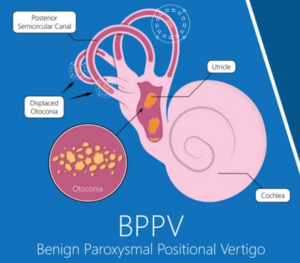Benign Paroxysmal Positional Vertigo: A Case Study
Abstract[edit | edit source]
Introduction [edit | edit source]
Client Characteristics[edit | edit source]
The patient is a 55 year old male who lives a relatively sedentary lifestyle and works as an accountant. He has high blood pressure which has been controlled by 40mg of Diovan daily. The patient also has high cholesterol in which he takes 5mg of crestor daily to help control. The patient enjoys gardening, driving with his wife and walking his dog. He complains of nausea, dizziness and the feeling of the room spinning. He is planning on retiring and is nervous about not being able to do what he wants and enjoy his retirement because of his symptoms. He first noticed symptoms 2 weeks ago while turning his head quickly while driving. Following the onset, medications did not help symptoms and therefore he has since been getting treatment for BPPV. Sleeping has become increasingly difficult as any time he lays down he begins to feel dizzy.
Examination Findings[edit | edit source]
Subjective[edit | edit source]
Objective[edit | edit source]
Outcome Measures[edit | edit source]
Clinical Hypothesis[edit | edit source]
Physiotherapy Diagnosis[edit | edit source]
Problem List[edit | edit source]
Goals:
Short-term Goals:
- The pt wants to go 48 hours without any provocation of symptoms by the second week of treatment (14 days post-treatment).
- The patient wants to improve his dynamic gait index score to 20 by the 10th-day post-treatment.
Long-term Goals:
- Pt wants to be able to drive to work without feeling dizzy checking his blindspots (30 min drive) in 6 weeks.
- Pt wants to be able to play fetch with his dog for 20 minutes without an onset of symptoms from picking up the ball in 8 weeks.
Intervention[edit | edit source]
Upon the next treatment visit, vestibular rehabilitation was performed. The patient was taught Cawthrone-Cooksey exercises with a focus of training the eyes to move independently of the head. This consisted of performing exercises by gradually building up from one exercise to the next. Having the patient rate the severity of symptoms during the exercise on a scale of 0-5 (where 0 = no symptoms and 5 = severe symptoms) to pace the progression of exercises. Exercises may include gaze training, balancing in day-to-day situations, improving coordination (catching and throwing a ball, walking on incline, stooping) (14).







